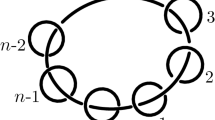Abstract
Many invariants of knots and links have their counterparts in braid theory. Often, these invariants are most easily calculated using braids. A braid is a set of n strings stretching between two parallel planes. This review demonstrates how integrals over the braid path can yield topological invariants. The simplest such invariant is the winding number – the net number of times two strings in a braid wrap about each other. But other, higher-order invariants exist. The mathematical literature on these invariants usually employs techniques from algebraic topology that may be unfamiliar to physicists and mathematicians in other disciplines. The primary goal of this paper is to introduce higher-order invariants using only elementary differential geometry.
Some of the higher-order quantities can be found directly by searching for closed one-forms. However, the Kontsevich integral provides a more general route. This integral gives a formal sum of all finite order topological invariants. We describe the Kontsevich integral, and prove that it is invariant to deformations of the braid.
Some of the higher-order invariants can be used to generate Hamiltonian dynamics of n particles in the plane. The invariants are expressed as complex numbers; but only the real part gives interesting topological information. Rather than ignoring the imaginary part, we can use it as a Hamiltonian. For n = 2, this will be the Hamiltonian for point vortex motion in the plane. The Hamiltonian for n = 3 generates more complicated motions.
Similar content being viewed by others
References
Aref, H., Rott, N. and Thomann, H.: Gröbli's solution of the three vortex problem, Ann. Rev. Fluid. Mech. 24 (1992), 1.
Arnol'd, V. I.: The cohomology ring of the coloured braid group, Math. Notes Acad. Sci. USSR 5 (1969), 227 (Math. Notes 5 (1974), 138).
Bar-Natan, D.: Bibliography of Vassiliev invariants, 2000, www.ma.huji.ac.il.drorbn.
Berger, M. A.: Third-order link integrals, J. Phys. A: Math. Gen. 23 (1990), 2787.
Berger, M. A.: Third-order braid invariants, J. Phys. A: Math. Gen. 24 (1991), 4027.
Berger, M. A.: Minimum crossing numbers for three-braids, J. Phys. A: Math. Gen. 27 (1994), 6205.
Berger, M. A.: Hamiltonian dynamics generated by Vassiliev invariants, J. Phys. A: Math. Gen. 34 (2001), 1363.
Birman, J. S.: Braids, Links, and Mapping Class Groups, Princeton Univ. Press, Princeton, NJ, 1974.
Birman J. S. and Lin, X. S.: Knot polynomials and Vassiliev's invariants, Invent. Math. 111 (1993), 225.
Boyland P. L., Aref, H. and Stremler, M. A.: Topological fluid mechanics of stirring, J. Fluid Mech. 403 (2000), 277.
Chen, K. T.: Iterated path integrals, Bull. Amer. Math. Soc. 83 (1997), 831.
Clausen, S., Helgesen, G. and Skjeltorp, A. T.: Braid description of collective fluctuations in a few-body system, Phys. Rev. E 58 (1998), 4229.
Cromwell, P., Beltrami, E. and Rampichini, M.: The Borromean rings, Math. Intelligencer 20 (1998), 53.
Chmutov, S. and Duzhin, S.: The Kontsevich integral, Act. Appl. Math. 66(2) (2001), 139–154.
Evans, W. N. and Berger, M. A.: A hierarchy of linking integrals, In: H. K. Moffatt, G. M. Zaslavsky, P. Comte and M. Tabor (eds), Topological Aspects of the Dynamics of Fluids and Plasmas, Santa Barbara, NATO ASI Proc. 237, Kluwer Acad. Publ., Dordrecht, 1992.
Fenn, R. A.: Techniques of Geometric Topology, London Math. Soc. Lecture Note Ser. 57, Cambridge Univ. Press, Cambridge, 1983.
Kontsevich, M.: Vassiliev's knot invariants, Adv. Soviet Math. 16 (1993), 137.
Laurence, P. and Stredulinsky, E.: Asymptotic Massey products, induced currents and Borromean torus links, J. Math. Phys. 41 (2000), 3170.
Monastrysky, M. I. and Retakh, V.: Topology of linked defects in condensed matter, Comm. Math. Phys. 103 (1986), 445.
Monastrysky, M. I. and Sasarov, P. V.: Topological invariants in magnetic hydrodynamics, Soviet Phys. JETP 93 (1987), 1210.
Moore, C.: Braids in classical dynamics, Phys. Rev. Lett. 70 (1993), 3675.
Ruzmaikin, A. and Akhmetiev, P.: Topological invariants of magnetic fields, and the effect of reconnections, Phys. Plasmas 1 (1994), 331.
Vassiliev, V. A.: Cohomology of knot spaces, Adv. Soviet Math. 1 (1990), 23.
Willerton, S.: PhD Thesis, University of Edinburgh, 1997.
Author information
Authors and Affiliations
Rights and permissions
About this article
Cite this article
Berger, M.A. Topological Invariants in Braid Theory. Letters in Mathematical Physics 55, 181–192 (2001). https://doi.org/10.1023/A:1010979823190
Issue Date:
DOI: https://doi.org/10.1023/A:1010979823190




